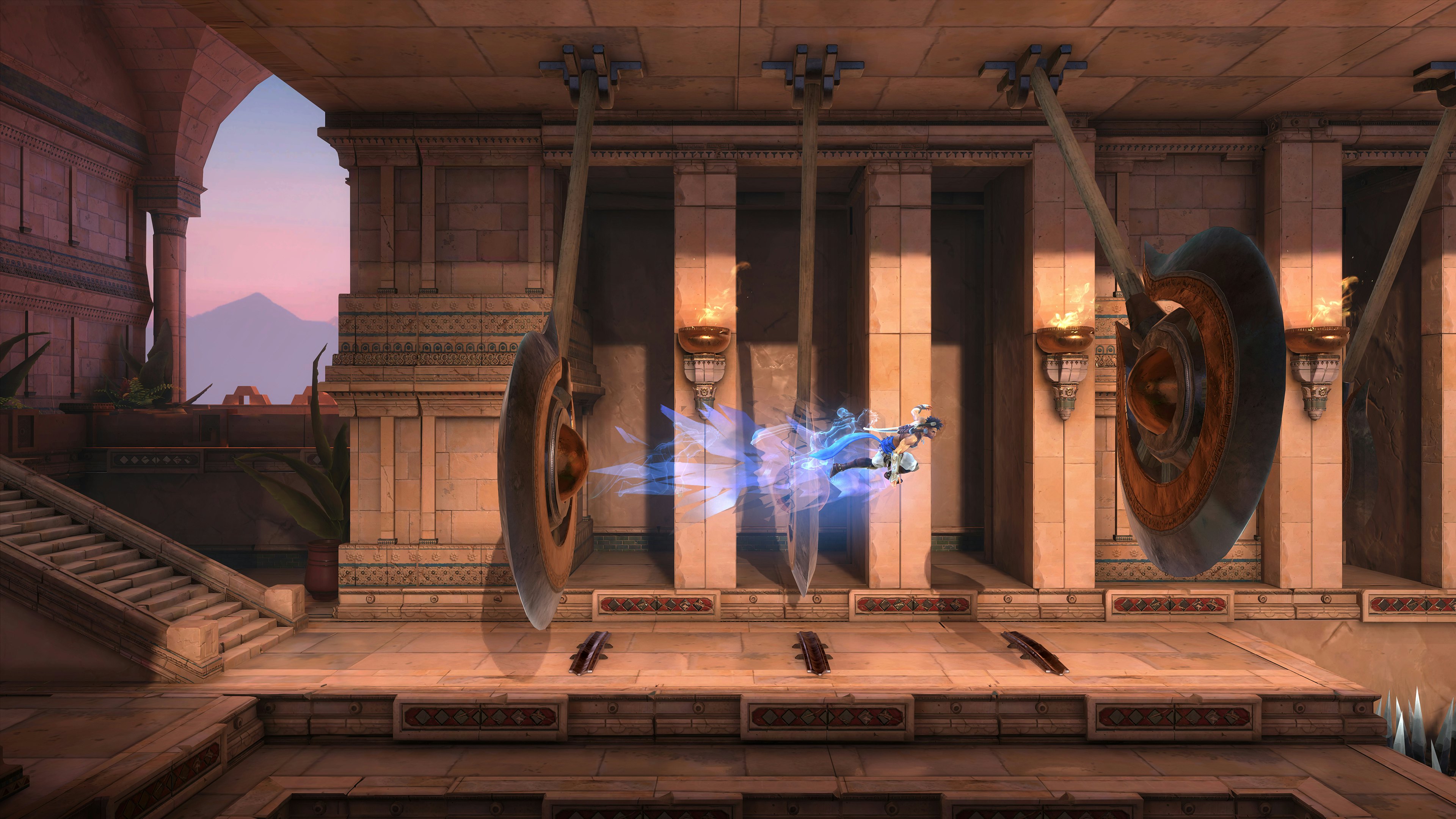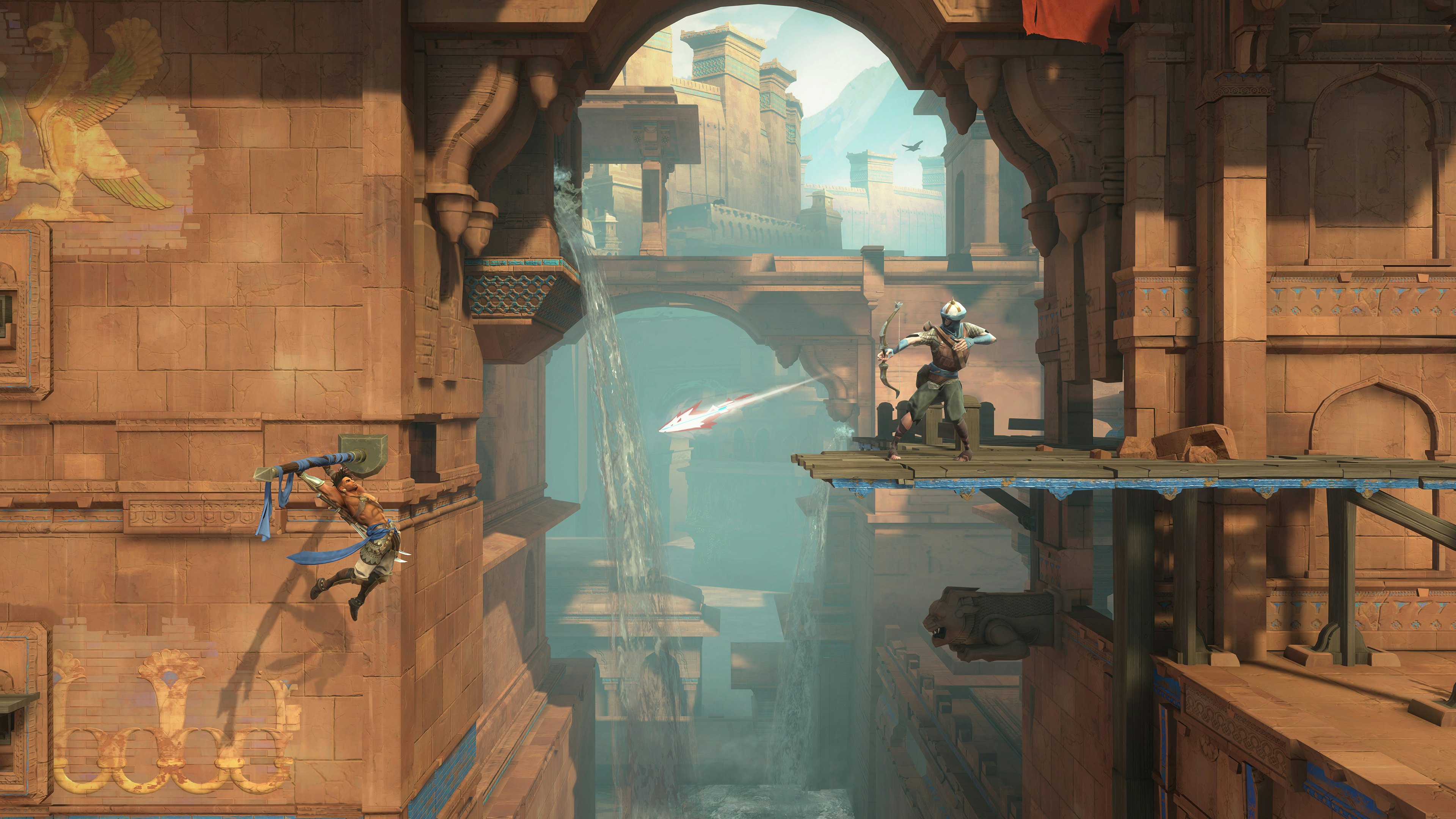
Sargon races along a battlefield with his fellow Immortals — a group of Persia’s mightiest warriors. Backlit by the sun setting in a blood-red sky, the group charges through enemy ranks, felling them with swords and arrows. At some points, two or three Immortals appear on screen at once to fight off hordes of enemies. You’re in the thick of battle with an elite troop against overwhelming odds. Unfortunately, nothing quite that interesting ever happens again as Prince of Persia: The Lost Crown settles into a fun but flawed Metroidvania for the rest of its 20-odd hours.
The Lost Crown is, in some ways, a throwback to Prince of Persia’s platforming roots, replacing the original’s dungeons with Mount Qaf, an isolated mountain fortress where time has gone wrong, trapping its inhabitants in a world where time is frozen in some places and disastrously accelerated in others. After a short intro level, Sargon’s mentor betrays Persia’s queen, kidnapping her son for unknown purposes and heading for Mount Qaf. Plot twists and time shenanigans ensue, but The Lost Crown is not nearly as interested in its story as its gameplay.
Warrior Within

Actually playing The Lost Crown feels nothing like playing any other Prince of Persia game thanks to its Metroidvania structure, which requires more exploration than usual. While the basic formula, pioneered by ‘80s classics Metroid and Castlevania is tried and true, The Lost Crown adds one unique twist with the ability to save an image of your screen and pin it to the map to remind you what obstacles are blocking progress there — a feature I’d love to see other games pick up.
Combat is an essential part of the genre, and The Lost Crown has one of the most satisfying melee systems I’ve ever seen in this type of game. Armed with twin swords, Sargon can pull off combos that feel like bare-bones versions of a fighting game from the very start. In addition to basic attacks, you start with a few moves that knock enemies into the air, setting you up to juggle them, engage them while they’re helpless, or make some distance to heal. Instead of button-mashing, you’ll need to read enemies’ tells and memorize attack patterns to know when to attack, dodge, or — most importantly — parry.
I love a good parry. There are few things as satisfying as nailing a perfectly timed button press to send an enemy’s attack clanging away, leaving them open for a counterattack. And The Lost Crown has an excellent parry. It can brush almost any attack aside, even if that attack happens to come from a 30-foot-tall manticore. Nearly every enemy in the game also has powerful attacks marked by a yellow flash that do serious damage if they connect, but can be parried for a devastating counterattack.

Combat feels great one-on-one, but things get muddy quickly when you’re facing multiple enemies. As fun as it can be to take on a whole gang of assassins at once, The Lost Crown’s idea of increasing challenge often means faster enemies with difficult-to-avoid attacks that can send you flying across the screen. With even a few attacking at once, I often lost complete control of my character.
Boss fights are also a mixed bag. They’re certainly impressive, ranging from giant beasts to human opponents with versatile toolkits to keep you on your toes. But they rarely demand you use the abilities you unlock over the course of the game, and just one boss actually incorporates the game’s time-warping theme into its attacks. Even the more interesting fights have their issues, like a battle against a woman riding a giant wolf that replicates so much of Hollow Knight’s great Mantis Lords fight it feels more like a pale imitation than an homage.
Time and Space

The abilities you gain throughout The Lost Crown are made for exploration more than combat, and that’s where they shine. Like any Metroidvania, new abilities give you new ways to traverse the map and unlock new paths.
One power switches certain walls and platforms on and off, which the game describes as you moving to a different dimension — though the only apparent difference between dimensions is where platforms are. Another leaves a shadow copy of Sargon when you activate it, then lets you teleport back to that point by pressing the button again.
When combined with your standard combat abilities, these add up to some incredible platforming segments. By the end of the game, you’ll face puzzles that have you jumping toward a spiked floor, freezing your shadow in midair, falling through a toggleable platform, activating a switch with your bow, then warping back to your shadow at the last moment and activating the platform before you land on it. It’s thrilling. No matter how many times I play through variations of these ultra-acrobatic challenges, they never get old.
Moving through these focused platforming challenges feels fantastic, but moving through the world at large is far less exciting. One of the greatest joys of a good Metroidvania is unlocking a new ability and realizing you can finally use it to reach a treasure that’s been taunting you or find your way to another enticing discovery. I just never felt that playing The Lost Crown.
For one thing, the different regions of its massive map are mostly isolated, without the intricate connections and looping shortcuts that define games like Dark Souls or Hollow Knight — both clear inspirations on The Lost Crown. They don’t offer particularly exciting paths within regions either. The Lost Crown is full of giant, mostly empty rooms dotted with platforms and bars to swing on, and not a lot of memorable architecture. That problem becomes much bigger when you’re constantly backtracking, thanks to the Metroidvania structure and a severe lack of fast travel points.

Only two areas stick in my mind after finishing the game. One late-game area, the Raging Sea, is set on the ocean, where a ship was frozen in time at the moment it crashed due to Mount Qaf’s strange temporal properties. The level consists of platforms made from chunks of ship flying off at strange angles, with panicked sailors in the background frozen in their attempts to put out fires that now stand still. It’s the only area in the game that actually plays with the idea of time standing still, and it’s easily its most memorable environment.
The other spot that sticks with me is the Sacred Archives. While it lacks the engaging theme of the Raging Sea, the Sacred Archives is home to The Lost Crown’s most frantic platforming challenges and populated by some of the game’s most pain-in-the-ass enemies, so you constantly feel the pressure to keep moving. If the game had followed its template of turning entire rooms into deadly puzzles, it would have been better for it.
In its combat and tricky platforming sections, The Lost Crown is mostly a blast. The problem is that it’s surrounded by dull exploration, frequently underwhelming bosses, and enough small frustrations to keep it from greatness. I’m baffled at how little it dives into its unique frozen-time premise, because the moments where it does are the best parts of the game. The Lost Crown’s high points are enough to recommend it to anyone looking for a good action platformer, but if you want a game that scratches the itch for satisfying exploration, you may walk away disappointed.
6/10
Prince of Persia: The Lost Crown launches on January 18 for Nintendo Switch, PS4, PS5, Xbox One, Xbox Series X/S, and PC. Inverse reviewed the game on PS5.
INVERSE VIDEO GAME REVIEW ETHOS: Every Inverse video game review answers two questions: Is this game worth your time? Are you getting what you pay for? We have no tolerance for endless fetch quests, clunky mechanics, or bugs that dilute the experience. We care deeply about a game’s design, world-building, character arcs, and storytelling come together. Inverse will never punch down, but we aren’t afraid to punch up. We love magic and science-fiction in equal measure, and as much as we love experiencing rich stories and worlds through games, we won’t ignore the real-world context in which those games are made.




!["[T]he First and Fifth Amendments Require ICE to Provide Information About the Whereabouts of a Detained Person"](https://images.inkl.com/s3/publisher/cover/212/reason-cover.png?w=600)


